Maintenance and Optimization of Ecological Space in Natural Resource-Advantaged Cities: A Case Study in Zhangzhou, Fujian Province
Abstract
:1. Introduction
2. Research Object and Methods
2.1. Overview of the Research Area
2.2. Data Sources
2.3. Research Method
2.3.1. Ecological Source Identification Based on the MSPA Method
2.3.2. Identification of Important Ecological Source Areas and Evaluation of Landscape Connectivity
- (1)
- Overall connectivity index (IIC) and possible connectivity index (PC):
- (2)
- Patch importance (dI):
2.3.3. Construction of Ecological Resistance Surface
2.3.4. Potential Ecological Corridor Construction Based on the MCR Model
2.3.5. Extraction of Important Ecological Corridors Based on the Gravity Model
3. Results and Analysis
3.1. Identification and Analysis of Ecological Source Area
3.1.1. Landscape Pattern Analysis Based on MSPA
3.1.2. Extraction and Analysis of Important Ecological Source Areas
3.2. Analysis of Ecological Network Construction
3.2.1. Extraction and Analysis of Potential Ecological Corridors Based on the MCR Model
3.2.2. Identification and Analysis of Important Ecological Corridors
3.3. Optimization of the Ecological Network in Zhangzhou City
3.3.1. Maintenance and Addition of Ecological Source Areas
3.3.2. Construction of the Pedal Stone
3.3.3. Restoration of Ecological Fracture Points
4. Conclusions and Prospects
4.1. Conclusions
- (1)
- The ecological area and the construction land area in Zhangzhou city showed a significant opposition, the resistance factor of the ecological advantage area was small, and the ecological resistance of the construction land area increased markedly. The core area of the Zhangzhou landscape pattern identified by the MSPA method is approximately 3954.19 km2, accounting for 31.25% of the total area of the study area and 83.51% of the total area of the ecological landscape. The single patch area of the core area is large, and it is mainly distributed in the northwest region of Zhangzhou and scattered and fragmented in the southeast. This is also consistent with the current polarization of Zhangzhou City and the forest region.
- (2)
- Based on the landscape connectivity index dIIC, dPC, and Id, 18 important core areas and nearly 57 secondary ecological sources were selected, accounting for 55% of the core area. They were mainly distributed in the western and northern areas of Zhangzhou, while the coastal areas in the middle, east, and south are obviously short of large ecological sources.
- (3)
- Based on the MCR model and gravity model, 21 important corridors, 51 secondary corridors, and 81 general corridors were extracted. The purpose was to maintain and repair the biological corridor in the east-west and north-south coastal directions of Zhangzhou City and further optimize the stability of the ecological network by maintaining the scale of urban construction land.
- (4)
- We suggest adding six new ecological source areas along the central and eastern, western, and southern coasts of Zhangzhou city. Additionally, 29 stepping stones and 20 ecological fracture points should be set for the whole ecological network.
4.2. Prospects and Shortcomings
Author Contributions
Funding
Data Availability Statement
Conflicts of Interest
References
- Pang, B.; Li, X.X.; Zhang, Y.Z.; Fu, Y.; Song, X.C. Analysis of the Decoupling Relationship and Driving Factors between Economic Development and Environmental Pollution in New First-Tier Cities. Ecol. Econ. 2022, 38, 192–197. [Google Scholar]
- Song, M.L.; Cui, L.B.; Zhou, Y.X. Management system and institution of natural resources in China: Status, problems and prospects. J. Nat. Resour. 2022, 37, 1–16. [Google Scholar]
- Zhang, Y.J.; Yu, B.Y. Analysis of urban ecological network space and optimization of ecological network pattern. Acta Ecol. Sin. 2016, 36, 6969–6984. [Google Scholar]
- Su, K.; Yu, Q.; Yang, D. Simulation of Forest-grass Ecological Network Based on Multi-scene Model in Typical Desert-oasis Ecotone. Trans. Chin. Soc. Agric. Mach. 2019, 9, 243–253. [Google Scholar]
- Liu, X.; Jiao, Y.; Wang, M.; Zhang, K. Evaluation of key nodes and corridors of river and canal network in Hani Rice Terraces based on graph theory. Chin. J. Ecol. 2018, 1, 287–294. [Google Scholar]
- Tang, P.; Wang, H. Analysis on the suitability of green sponge space in modern city based on MCR model. J. Nanjing For. Univ. Nat. Sci. Ed. 2019, 3, 116–122. [Google Scholar]
- Wang, Y.Y.; Shen, C.Z.; Jin, X.B.; Bao, G.Y.; Liu, J.; Zhou, Y.K. Developing and optimizing ecological networks based on MSPA and MCR model. Ecol. Sci. 2019, 2, 138–145. [Google Scholar]
- Peng, J.; Zhao, H.J.; Liu, Y.X.; Wu, J.S. Research progress and prospect on regional ecological security pattern construction. Geogr. Res. 2017, 3, 407–419. [Google Scholar]
- Hou, P.; Wang, Q.; Shen, W.M.; Zhai, J.; Liu, H.M.; Yang, M. Progress of integrated ecosystem assessment: Concept, framework and challenges. Geogr. Res. 2015, 10, 1809–1823. [Google Scholar]
- Conine, A.; Xiang, W.N.; Young, J.; Whitley, D. Planning formulti-purposegreen-ways in Concord, North Carolina. Landsc. Urban Plan. 2004, 68, 271–287. [Google Scholar] [CrossRef]
- Fábos, J.G. Green way plann in gin the United States: Its origins and recent case studies. Landsc. Urban Plan. 2004, 68, 321–334. [Google Scholar] [CrossRef]
- Xie, H.W.; Zhou, N.X.; Guan, J. The construction and optimization of ecological networks based on natural heritage sites in Jiangsu Province. Acta Ecol. Sin. 2014, 22, 6692–6700. [Google Scholar]
- Gu, F.; Huang, Y.X.; Chen, C.M.; Cheng, D.L.; Guo, J.L. Construction and optimization of ecological network for nature reserves in Fujian Province, China. Chin. J. Appl. Ecol. 2017, 3, 1013–1020. [Google Scholar]
- Biondi, E.; Casavecchia, S.; Pesaresi, S.; Zivkovic, L. Natura 2000 and the Pan-European ecological network: A new methodology for data integration. Biodivers. Conserv. 2012, 21, 1741–1754. [Google Scholar] [CrossRef]
- Yang, Z.G.; Jiang, Z.Y.; Guo, C.X.; Yang, X.J.; Xu, X.J.; Ui, X.; Hu, Z.M.; Zhou, H.Y. Construction of ecological network using morphological spatial pattern analysis and minimal cumulative resistance models in Guangzhou City, China. Chin. J. Appl. Ecol. 2018, 10, 3367–3376. [Google Scholar]
- Meng, J.J.; Wang, Y.; Wang, X.D.; Zhou, Z.; Sun, N. Construction of Landscape Ecological Security Pattern in Guiyang Based on MCR Model. Resour. Environ. Yangtze Basin 2016, 7, 1052–1061. [Google Scholar]
- Jing, Y.B.; Sun, X.; Liu, J.; Sun, D.J. Construction of Ecological Corridor in Etuoke Banner of Inner Mongolia Based on MCR Model. Bull. Soil Water Conserv. 2021, 2, 170–177. [Google Scholar]
- Hu, M.J.; Sun, P.; Li, Z.J.; Hou, B. Decoupling effect of economic growth and resource environment in the Yangtze River Delta. World Reg. Stud. 2022, 31, 538–548. [Google Scholar]
- Guo, S.; Chen, M.; Liu, H. Coupling procedure and decoupling analysis of urbanization and resource environment: The study of Beijing. Geogr. Res. 2018, 37, 1599–1608. [Google Scholar]
- Wang, Y.; Wang, Y. Decoupling analysis and influence factors between resource environment and economic growth in Beijing-Tianjin-Hebei region. Econ. Geogr. 2019, 39, 43–49. [Google Scholar]
- Yu, J.; Tang, B.; Chen, Y.; Zhang, L.; Nie, Y.; Deng, W. Landscape ecological risk assessment and ecological security pattern construction in landscape resource-based city: A case study of Zhangjiajie City. Acta Ecol. Sin. 2022, 42, 1290–1299. [Google Scholar]
- Li, H.; Liu, Y.; Li, Q.; Wang, X. Analysis of Ecological Security Pattern of Southern Rare Earth Mining Area Based on MCR Model. Sci. Geogr. Sin. 2020, 6, 989–998. [Google Scholar]
- Dong, B.; Zhang, M.; Mu, H.; Su, X. Study on decoupling analysis between energy consumption and economic growth in Liaoning province. Energy Policy 2016, 97, 414–420. [Google Scholar] [CrossRef]
- Xia, Y.; Zhong, M. Relationship between EKC hypothesis and the decoupling of environmental pollution from economic development: Based on China prefecture-level cities’ decoupling partition. China Popul. Resour. Environ. 2016, 26, 8–16. [Google Scholar]
- Kuang, W.H.; Liu, J.Y.; Lu, D.S. Pattern of impervious surface change and its effect on water environment in the Beijing-Tianjin-Tangshan metropolitan area. Acta Geogr. Sin. 2011, 66, 1486–1496. [Google Scholar]
- Jin, Y.; Lu, Z.; Tan, F.; Zhang, M.; Zhang, H. Assessment of ecological carrying capacity on the typical resources-based cities: A case study of Tangshan City. Acta Ecol. Sin. 2015, 35, 4852–4859. [Google Scholar]
- Liu, Y.D.; He, Z.W.; Chen, J.H.; Xie, C.; Xie, T.Z.; Mu, C.L. Ecological Network Construction Method Based on MSPA and MCR Model: Taking Nanchong as Example. Southwest China J. Agric. Sci. 2021, 2, 354–363. [Google Scholar]
- Li, X.F.; Weng, F.F.; Chen, R.R.; Liu, X.Z.; Ding, Z. Ecological network construction based on MSPA and MCR model–Taking Xinxiang City as an example. J. Henan Inst. Sci. Technol. Nat. Sci. Ed. 2022, 1, 45–54. [Google Scholar]
- Santiago, S.; Luc, A. A new habitat availability index to integrate connectivity in landscape conservation planning: Comparison with existing indices and application to a case study. Landsc. Urban Plan. 2007, 83, 91–103. [Google Scholar]
- Saura, S.; Estreguil, C.; Mouton, C.; Rodríguez-Freire, M. Network analysis to assess landscape connectivity trends: Application to European forests (1990–2000). Ecol. Indic. 2010, 11, 407–416. [Google Scholar] [CrossRef]
- Santiago, S.; Lin, R. A common currency for the different ways in which patches and links can contribute to habitat availability and connectivity in the landscape. Ecography 2010, 33, 523–537. [Google Scholar]
- Rjan, B.; Santiago, S. Ranking individual habitat patches as connectivity providers: Integrating network analysis and patch removal experiments. Ecol. Model. 2010, 221, 2393–2405. [Google Scholar]
- Wang, G.; Yu, Q.; Yang, D.; Zhang, Q.B.; Yue, D.P.; Liu, J.H. Hierarchical ecological network structure based on complex network analysis. Trans. Chin. Soc. Agric. Mach. 2019, 50, 258–266+312. [Google Scholar]
- Chen, Y.; Zhang, Z.; Yang, C.; Wan, L.; Ye, C.; Zhang, J.; Li, Q. Identifying risk areas and risk paths of non-point source pollution in Wuhua River Basin. Acta Geogr. Sin. 2018, 73, 1765–1777. [Google Scholar]
- Cheng, J. An Ecological Study on Characteristic Agriculture in Southeast of Fujian Province—A Case Study of Zhangzhou City. Master’s Thesis, Fujian Normal University, Fuzhou, China, 2001. [Google Scholar]
- Huang, Y.C. Study on the Ecosystem Services Value in Response to Land Use Change in Zhangzhou. Master’s Thesis, Fujian Normal University, Fuzhou, China, 2009. [Google Scholar]
- Lian, P.P. Study on the Assessment and Strategy of Modern Agricultural Development of Zhangzhou City from the Perspective of Eco-Civilization. Master’s Thesis, Fujian Normal University, Fuzhou, China, 2014. [Google Scholar]
- Zhangzhou Bureau of Statistics. Zhangzhou Statistical Yearbook, 2021. Available online: http://tjj.zhangzhou.gov.cn/cms/html/zzstjj/tjnj/index.html (accessed on 24 August 2022).
- Soille, P.; Vogt, P. Morphological Segmentation of Binary Patterns. Pattern Recognit. Lett. 2009, 4, 456–459. [Google Scholar] [CrossRef]
- Wu, C.G.; Zhou, Z.X.; Wang, P.C.; Xiao, W.F.; Teng, M.J. The concept and measurement of landscape connectivity and its applications. Acta Ecol. Sin. 2010, 7, 1903–1910. [Google Scholar]
- Yin, H.; Kong, F.; Qi, Y.; Wang, H.; Zhou, Y.; Qin, Z. Developing and optimizing ecological networks in urban agglomeration of Hunan Province, China. Acta Ecol. Sin. 2011, 10, 2863–2874. [Google Scholar]
- Shi, X.M.; Qin, M.Z.; Li, B.; Li, C.Y.; Song, L.L. Research on the Green Infrastructure Network in the Zhengzhou-Kaifeng Metropolitan Area Based on MSPA and Circuit Theory. J. Henan Univ. Nat. Sci. 2018, 6, 631–638. [Google Scholar]
- Li, J.; Meng, J.J.; Mao, X.Y. MCR Based Model for Developing Land Use Ecological Security Pattern in Farming-Pastoral Zone: A Case Study of Jungar Banner, Ordos. Acta Sci. Nat. Lium Univ. Pekin. 2013, 4, 707–715. [Google Scholar]
- Hua, Y.; Li, G.Z.; Gao, G.H. Application of Stepping Stone Principle in Design of Nature Reserve. Chin. Wildl. 2013, 4, 30–31. [Google Scholar]
- Song, Q.I.; Luo, Z.J.; Chen, Y.Y.; Zhao, J.; Lin, X.X. Construction and optimization of Ecological Network in Yuanzhou District Based on MSPA and the Least-Cost Path Method. Res. Agric. Mod. 2020, 41, 351–360. [Google Scholar]
- Zhou, Y.; Zhang, Q.N. Impacts of road networks on species migration and landscape connectivity. Chin. J. Ecol. 2014, 2, 440–446. [Google Scholar]
- Hoctor, T.S. Regional Landscape Analysis and Reserve Design to Conserve Florida’s Biodiversity; University of Florida: Gainesville, FL, USA, 2003. [Google Scholar]
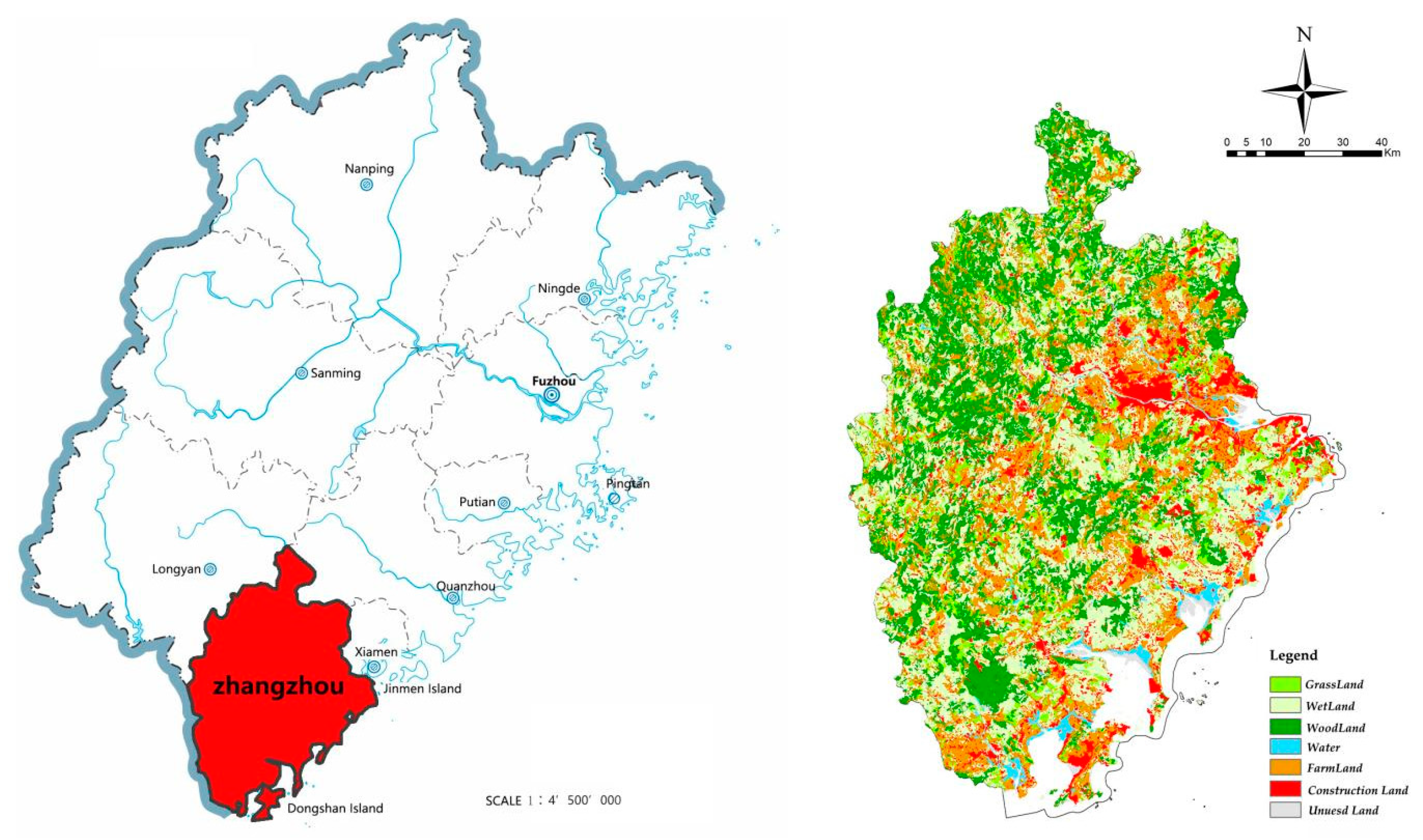
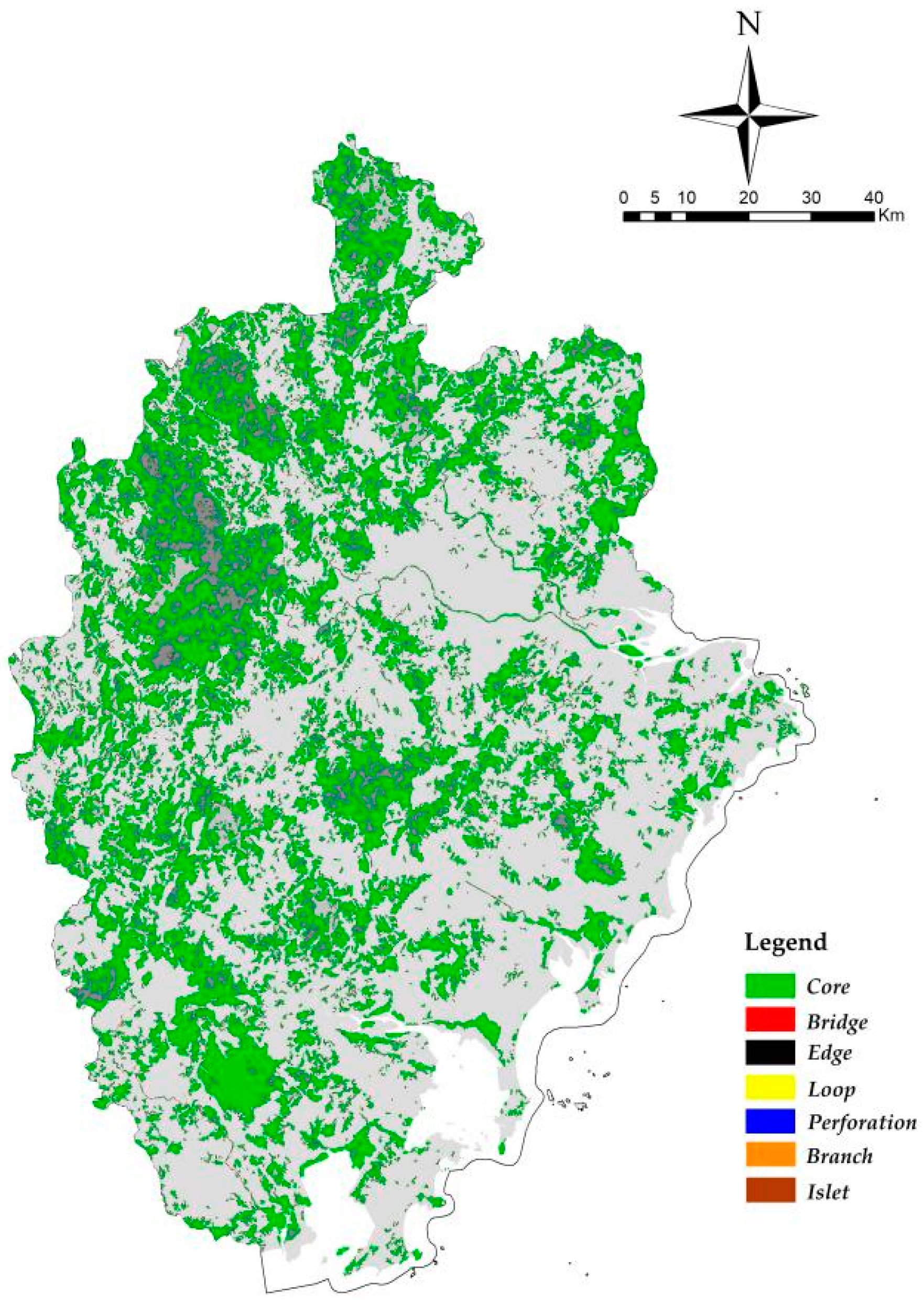
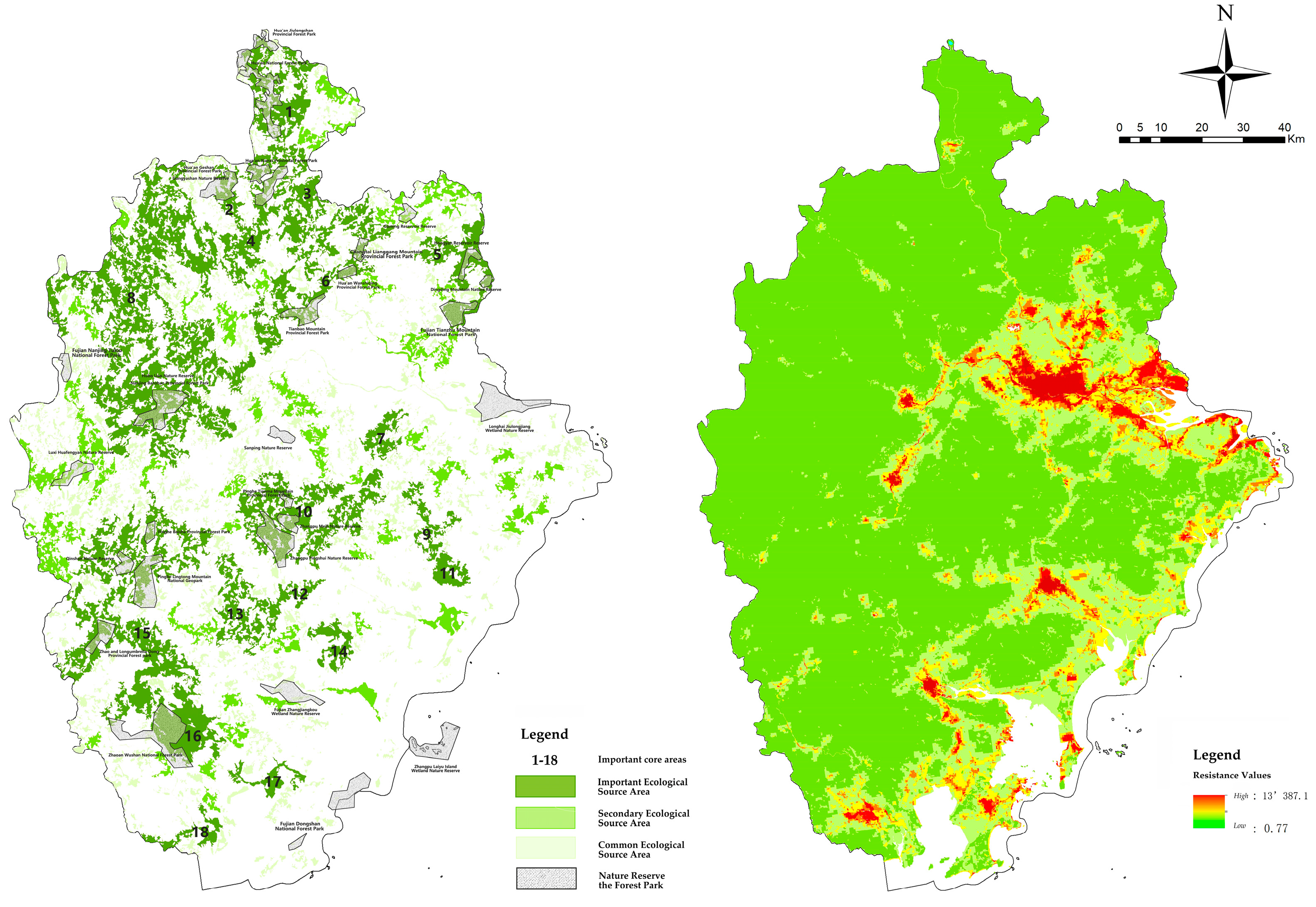
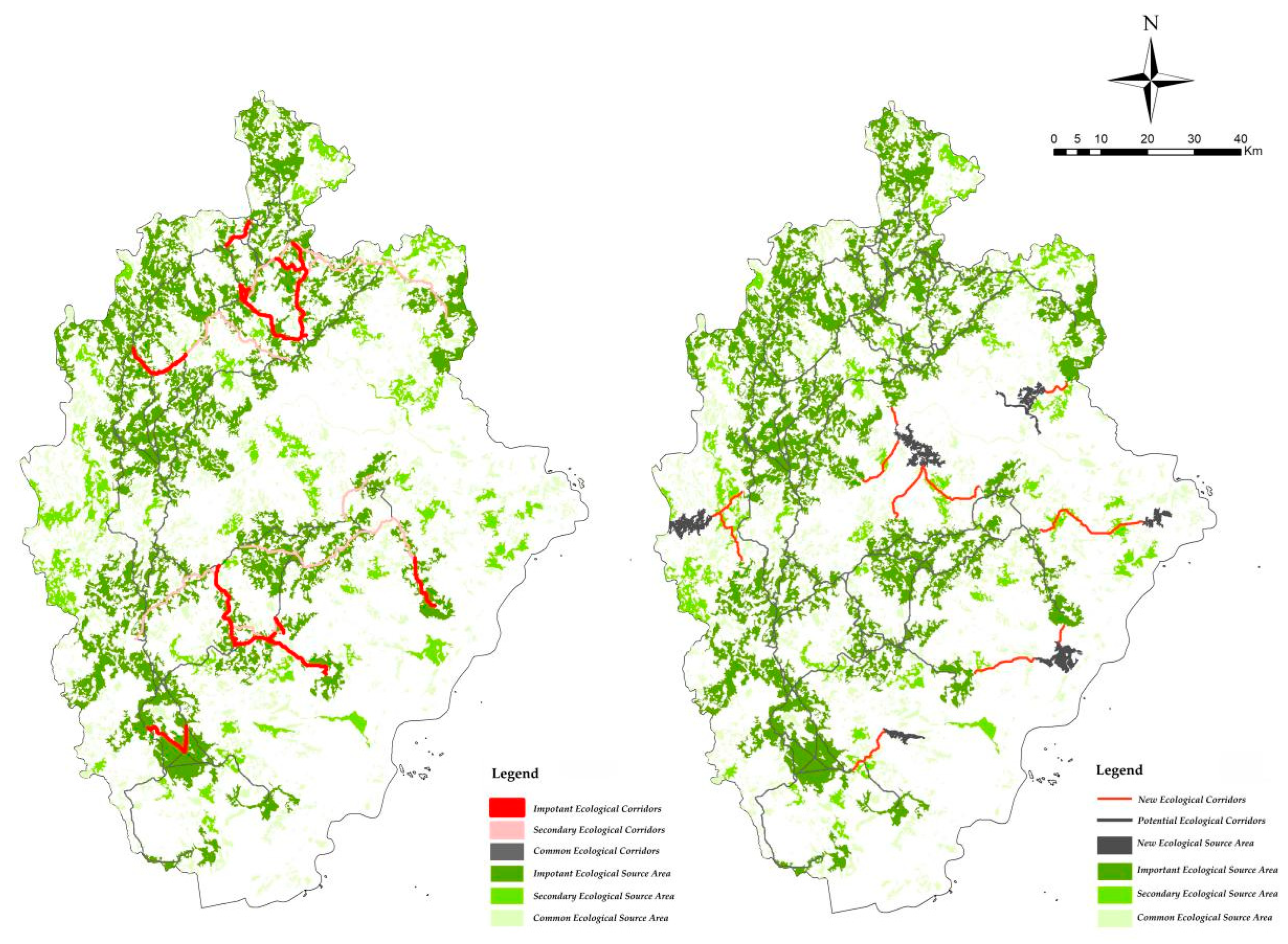
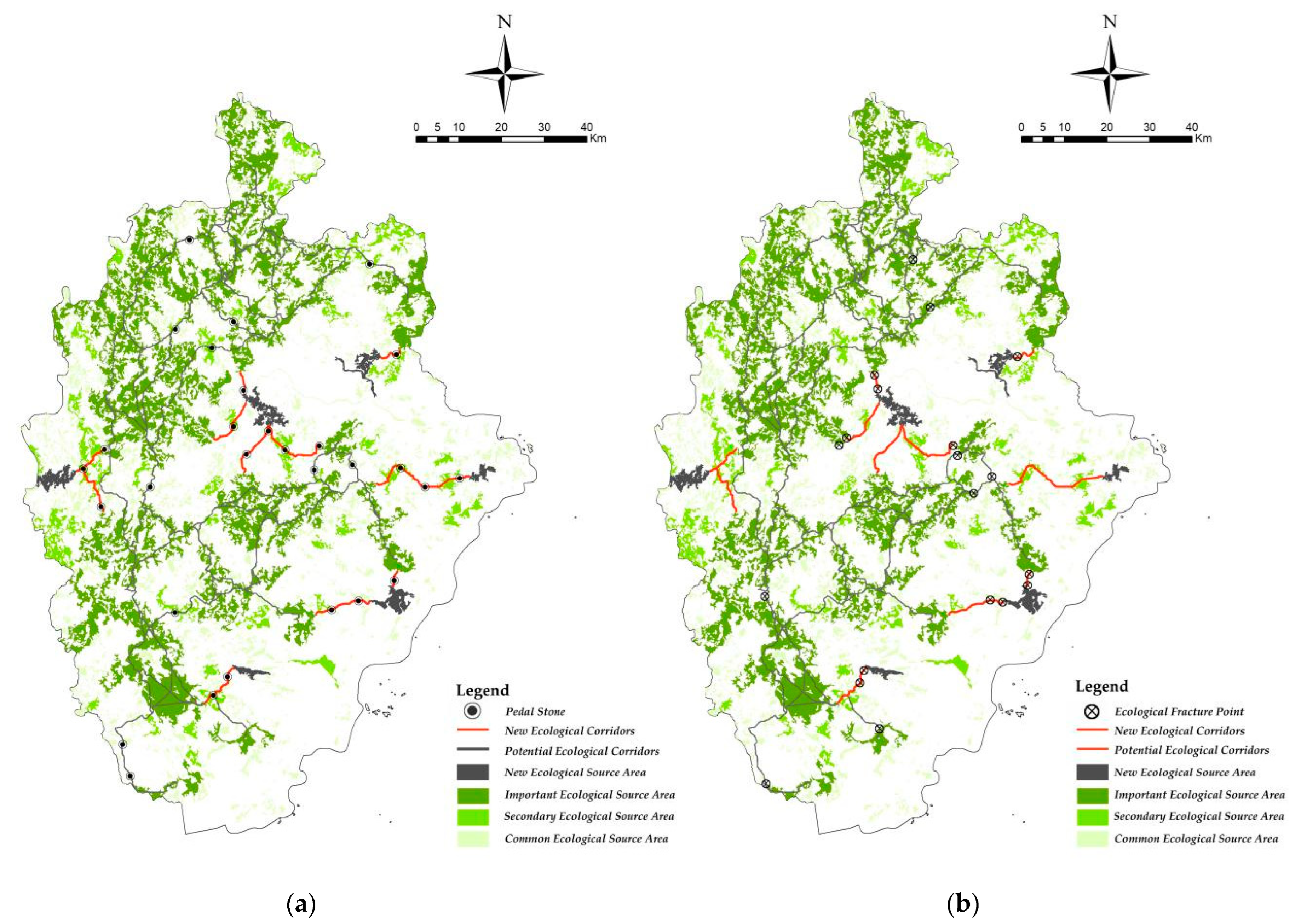
| Land Type | Woodland | Grassland | Wetland | Water | Farmland | Construction Land | Other |
|---|---|---|---|---|---|---|---|
| Base resistance value | 3 | 50 | 50 | 500 | 100 | 1000 | 700 |
| Landscape Types 1 | Area /km2 | Study Area Area Ratio | Total Ecological Landscape Area Ratio |
|---|---|---|---|
| Core | 3954.19 | 31.25% | 83.51% |
| Bridge | 9.18 | 0.07% | 0.19% |
| Edge | 610.51 | 4.83% | 12.89% |
| Loop | 1.59 | 0.01% | 0.03% |
| Perforation | 118.51 | 0.94% | 2.50% |
| Branch | 40.88 | 0.32% | 0.86% |
| Islet | 0.24 | 0.00% | 0.01% |
| Total | 4735.11 | 37.42% |
| No | dI | dIIC | dPC | Area/km2 | No | dI | dIIC | dPC | Area/km2 |
|---|---|---|---|---|---|---|---|---|---|
| 1 | 7.79 | 12.31 | 15.23 | 189.88 | 10 | 9.08 | 16.24 | 17.89 | 221.39 |
| 2 | 1.30 | 2.05 | 2.63 | 31.59 | 11 | 1.32 | 1.89 | 2.30 | 32.26 |
| 3 | 4.49 | 7.44 | 9.20 | 109.36 | 12 | 1.37 | 2.36 | 3.03 | 33.39 |
| 4 | 3.13 | 5.49 | 6.92 | 76.44 | 13 | 3.19 | 5.50 | 6.68 | 77.70 |
| 5 | 4.54 | 7.61 | 8.35 | 110.78 | 14 | 1.59 | 2.70 | 2.94 | 38.87 |
| 6 | 5.39 | 9.64 | 11.36 | 131.41 | 15 | 15.73 | 27.46 | 31.01 | 383.57 |
| 7 | 1.50 | 2.63 | 3.35 | 36.56 | 16 | 5.49 | 9.14 | 11.52 | 133.80 |
| 8 | 29.90 | 55.01 | 56.14 | 729.12 | 17 | 1.29 | 1.87 | 2.47 | 31.38 |
| 9 | 1.62 | 2.80 | 3.19 | 39.45 | 18 | 1.28 | 1.75 | 2.30 | 31.27 |
| NO | 1 | 2 | 3 | 4 | 5 | 6 | 7 | 8 | 9 | 10 | 11 | 12 | 13 | 14 | 15 | 16 | 17 | 18 |
|---|---|---|---|---|---|---|---|---|---|---|---|---|---|---|---|---|---|---|
| 1 | 0 | 3374.4 | 4013.4 | 2395.7 | 289.0 | 467.4 | 235.1 | 69.5 | 47.1 | 47.5 | 19.3 | 75.6 | 71.8 | 135.0 | 98.9 | 241.2 | 0.1 | 0.7 |
| 2 | 0.0 | 3984.6 | 15,658.2 | 550.5 | 1418.0 | 1465.8 | 163.7 | 129.3 | 113.8 | 45.6 | 206.8 | 207.9 | 380.3 | 253.5 | 666.2 | 0.2 | 1.6 | |
| 3 | 0.0 | 6313.8 | 664.6 | 1202.6 | 401.5 | 85.0 | 61.3 | 58.5 | 23.6 | 98.2 | 95.2 | 177.5 | 125.2 | 313.9 | 0.1 | 0.9 | ||
| 4 | 0.0 | 550.7 | 2271.5 | 1634.1 | 138.8 | 114.4 | 97.0 | 38.7 | 182.6 | 184.8 | 338.7 | 219.9 | 585.1 | 0.2 | 1.3 | |||
| 5 | 0.0 | 430.0 | 96.2 | 60.1 | 34.2 | 40.2 | 16.7 | 55.2 | 49.9 | 95.6 | 77.5 | 175.5 | 0.1 | 0.7 | ||||
| 6 | 0.0 | 308.5 | 98.2 | 67.4 | 67.2 | 27.3 | 108.2 | 103.3 | 193.8 | 140.8 | 345.5 | 0.2 | 1.0 | |||||
| 7 | 0.0 | 56.9 | 55.9 | 73.5 | 27.2 | 41.0 | 21.3 | 57.0 | 50.5 | 74.9 | 0.0 | 0.3 | ||||||
| 8 | 0.0 | 292.9 | 204.6 | 80.0 | 464.6 | 509.1 | 902.8 | 507.9 | 1495.6 | 0.3 | 2.4 | |||||||
| 9 | 0.0 | 252.6 | 3113.3 | 71.1 | 33.7 | 92.9 | 82.5 | 116.4 | 0.1 | 0.4 | ||||||||
| 10 | 0.0 | 190.0 | 1107.9 | 303.3 | 1167.9 | 720.6 | 889.9 | 0.2 | 1.4 | |||||||||
| 11 | 0.0 | 60.5 | 30.1 | 80.5 | 73.5 | 105.3 | 0.1 | 0.4 | ||||||||||
| 12 | 0.0 | 206.8 | 9242.3 | 2449.5 | 1037.2 | 0.1 | 1.1 | |||||||||||
| 13 | 0.0 | 419.3 | 1167.7 | 1095.0 | 0.1 | 0.9 | ||||||||||||
| 14 | 0.0 | 426.2 | 829.4 | 0.2 | 1.5 | |||||||||||||
| 15 | 0.0 | 3395.6 | 0.3 | 2.3 | ||||||||||||||
| 16 | 0.0 | 0.6 | 5.6 | |||||||||||||||
| 17 | 0.0 | 0.0 | ||||||||||||||||
| 18 | 0 |
Publisher’s Note: MDPI stays neutral with regard to jurisdictional claims in published maps and institutional affiliations. |
© 2022 by the authors. Licensee MDPI, Basel, Switzerland. This article is an open access article distributed under the terms and conditions of the Creative Commons Attribution (CC BY) license (https://creativecommons.org/licenses/by/4.0/).
Share and Cite
Liu, Y.; Ding, M. Maintenance and Optimization of Ecological Space in Natural Resource-Advantaged Cities: A Case Study in Zhangzhou, Fujian Province. Sustainability 2022, 14, 11952. https://doi.org/10.3390/su141911952
Liu Y, Ding M. Maintenance and Optimization of Ecological Space in Natural Resource-Advantaged Cities: A Case Study in Zhangzhou, Fujian Province. Sustainability. 2022; 14(19):11952. https://doi.org/10.3390/su141911952
Chicago/Turabian StyleLiu, Yan, and Meichen Ding. 2022. "Maintenance and Optimization of Ecological Space in Natural Resource-Advantaged Cities: A Case Study in Zhangzhou, Fujian Province" Sustainability 14, no. 19: 11952. https://doi.org/10.3390/su141911952
APA StyleLiu, Y., & Ding, M. (2022). Maintenance and Optimization of Ecological Space in Natural Resource-Advantaged Cities: A Case Study in Zhangzhou, Fujian Province. Sustainability, 14(19), 11952. https://doi.org/10.3390/su141911952





